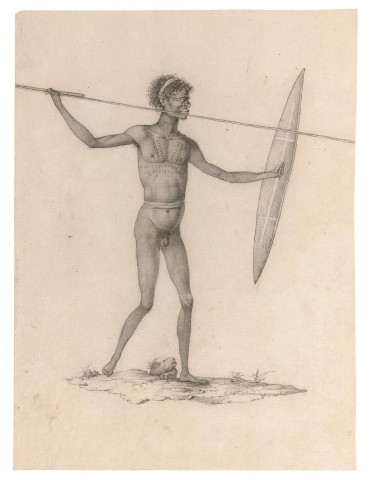(ABORIGINAL WARRIOR WITH SPEAR), June – November 1802
NICOLAS-MARTIN PETIT
pen, ink and graphite on laid paper with armorial watermark with fleur-de-lys
278 x 214 mm
signed and inscribed lower right: N. Petit à Bord du géographe
No engraving is based directly on this image. However the figure must be an early version of the man who would be included in the “Port-Jackson, Nlle Hollande cérémonie préliminaire d’un mariage, chez les sauvages” plate in the Freycinet atlas (no. 104)
See particularly B:20030 and 20044.1
A finely-rendered portrayal of a warrior from New South Wales advancing with his shield raised and spear held in his woomera. Petit has not only signed the work but noted that he drew it while “on board the Géographe”, which firmly dates the work as another voyage piece.
The man has a distinctive profile and, like many of the Sydney Aboriginal people drawn by Petit, has his hair tied back with a simple band. It is possible to make out several details of his distinctive scarification, with long vertical lines on both breasts, a series of shorter horizontal lines on his pectorals, and a long series of short lines around the torso. There is also evidence of some scars on his arms (but these are perhaps battlewounds rather than ornamentation?). Not only does the man brandish his spear, but the shield is very clearly of the famous crossed design seen in the finished plates as red on a white background, and he wears the belt or cincture around his waist which, as one of the plates in Baudin shows, was worn by men when facing combat so as to have a place to tuck in their club.
There is no full chalk or pastel image antecedent to this portrait. For the great formal portraits for which Petit is best known, he would make a quick preliminary sketch and then quickly follow this up with a grander coloured portrait: in Tasmania this was done in gouache, in Sydney in pastel (although why Petit made the change has never been explained). These were then used by the studio in Paris to prepare finished engravings.
There does however exist one preliminary sketch by Petit that is antecedent to the present work: it is largely done in outline but has identical scarification and obvious facial similarities, as well as the distinctive headband which allows the man’s very curly hair to fall forward on to his brow, as well as the unusual cincture of cloth around his abdomen (B:20030). These details might also mean that the present sketch is a profile of the man also shown at far left in a sketch of three men in a “corobré ou danse” (B:20044.1).
We do not doubt that there is more to be discovered about this portrait and its relationship with the similar studies in Le Havre. Perhaps the key will prove to be the notorious “marriage” scene engraved by Sébastien Leroy for inclusion in the Freycinet atlas of 1825 as plate 104, “Port-Jackson, Nlle. Hollande: cérémonie préliminaire d’un mariage, chez les sauvages.” In the finished version of the scene six men (three on each side) fight over a struggling woman in the middle, a seventh man stands at far left holding a spear over his shoulder in his woomera (two early studies for this work can be seen at lots 12 & 13 following). A close comparison of the man standing to the left, most particularly his general pose and the scarification on his torso, confirms that this must be the same man. This is doubly important because the plate is stated to be created by Leroy after “N. Petit.” Given we know the ways in which Freycinet rehabilitated and used the Baudin-era drawings to supplement his own publication, this is further striking evidence not only of how this work was done, but also of Freycinet’s early stewardship of the collection.
Moreover, it is also possible that the man was an important component of the work being done on another plate that was commissioned by Freycinet from the artist and engraver Pierre-Antoine Marchais, depicting a scene of ritual combat in New South Wales. Presumably meant for inclusion in the Freycinet atlas Historique (where it would have joined scenes such as the “marriage” plate), Marchais got as far as preparing a fine watercolour (Christie’s, Freycinet Collection, 2002, lot 95) and some engraver’s studies, but never issued a finished plate.
